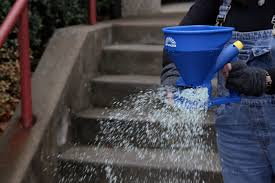As winter fast approaches, dealing with snow and ice in the Midwest is inevitable. To effectively manage slippery conditions on driveways and sidewalks, applying an ice melting product can help keep those areas safe.
1. Be Prepared
Don’t wait until the snow starts to fly and the temperature drops to freezing to purchase your ice melt. Watch the weather and have product on hand. Driving to a hardware store or gas station to pick up product after the fact only increases the possibility of a slip or fall during this delay.
Tip: Store ice melt products in a cool, dry place out of the reach of children and pets. Tightly seal/close any previously opened package.
2.Choose The Right Product
Ice melt is available in a variety of melting temperatures depending on the contents in the package. Rock salt (sodium chloride) is the base product for most deicers with blends containing magnesium chloride, calcium chloride or other products. Evaluate the contents in the bag and melting temperatures to determine which product best fits your environment.
Tip: Products that contain magnesium chloride or calcium chloride perform the best at the lowest temperatures.
3. Prepare the Area
For your ice melt product to be the most effective you need to apply it directly to your walking or driving surface. Remove as much snow or ice with a shovel or snow blower before applying your ice melting product.
Tip: Do not use ice melt on precast concrete products, brick, or on concrete less than a year old.
4. Application
Often when we see ice, our first instinct may be to dump a bunch of ice melt on the problem area in hopes that is just goes away. The truth is, using more than the recommended amount on the bag will not speed up the process, but will only lead to waste and add a higher cost for treatment. It is far more important that you pick the right product for the job and apply it according to the manufacturer’s instructions.
The best choice for spreading ice melt properly is to use a handheld, mechanical spreader for small areas, or a walk behind spreader for larger areas (i.e. parking lot or driveway). You can pick up a spreader at your local hardware or box store starting at $7.00.
Tip: Use an ice melt product that is dyed to assist you in knowing where you applied and minimize over-application.
5. Clean-up
As ice melt begins to work, slush and a brine is formed which makes clearing of compacted snow or ice easier to remove. Slush and brine not removed may leave a powdery, chalky residue in treated areas and can be tracked indoors. In addition, anything not removed is subject to refreezing which may require additional treatment.
Remove slush and brine as soon as possible to minimize damage to sidewalks or driveways as water may seep into cracks or air pockets and refreeze. As water expands, a hydraulic effect may cause the disruption or weakening of the surface.
Tip: Putting down mats inside and outside of entry doors can reduce tracking.
EC Grow ice melting products can be found at participating hardware stores, gas stations and independent retailers.




